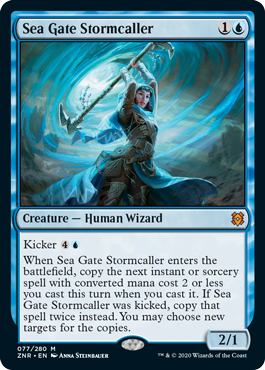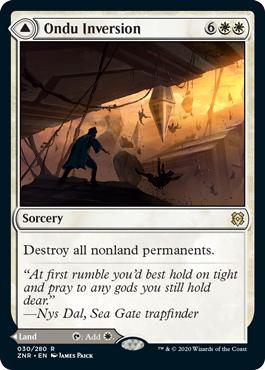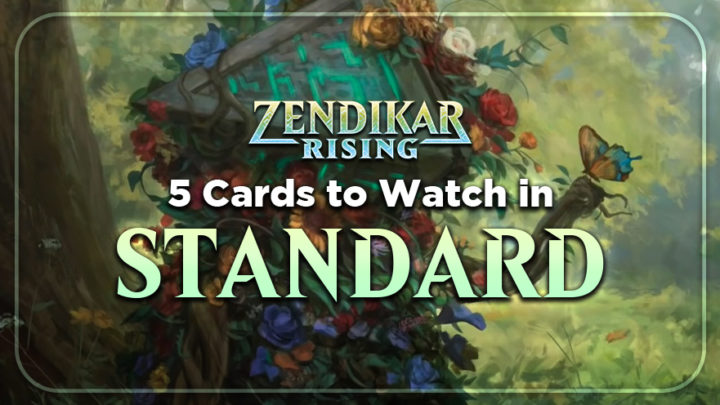We’re just one week away from the release of Zendikar Rising on MTG Arena and the start of a brand new Standard metagame. The last two years have been defined by amazing mana from Guilds of Ravnica and Ravnica Allegiance and the burst in power that came with War of the Spark — but next week, things will be completely different. It’s going to be exciting to see how these new cards slot into Standard and I think we are the precipice of an exciting new format.
In the meantime, I wanted to take some time to talk about five cards that are worth considering for Standard. Some of these cards will undoubtedly be big players, but others were overlooked during preview season. Let’s jump right in!
Bloodchief’s Thirst

Bloodchief’s Thirst is the next great removal spell in Standard. While it might be a sorcery, the ability to hit both planeswalkers and creatures cannot be understated.
One common problem we often see with cheap removal is that it’s hyper-conditional. Bloodchief’s Thirst without kicker is a great example of this — yes, you might be spending one mana to destroy something that costs two, but you’re probably not gaining a huge edge from that trade. But when you kick Thirst, suddenly you can answer almost every threat in the format, including planeswalkers. This is a card that will define the threats we play and the types of aggro decks that can exist in Standard.
You’ll likely get the most mileage out of Thirst in decks like Mono-Black Aggro. In Mono-Black, Thirst allows you to control the board until you can use cards like Rankle to run the opponent out of resources.
It also feels a bit silly to say that Thirst works really well with Uro — what doesn’t these days? — but it’s a powerful addition to an Uro shell. A lot of times Uro decks just want to trade card-for-card, then use Uro to take over the game; Thirst answers any threat your opponent could play, and thanks to Uro, you’ll probably have enough lands to pay the kicker cost. Plenty of people are going to be thirsty for a Thirst off the top for the next two years.
Sea Gate Stormcaller

Sea Gate Stormcaller is one of the most talked-about cards from Zendikar Rising so far, and rightfully so. Some folks are even comparing it to Snapcaster Mage! Personally, I think this card is weaker than Snapcaster, but that doesn’t mean we should throw this card aside.
The first thoughts I had for building around this card were admittedly very fair. Stormcaller and kicker work nicely together, since kicker doesn’t affect the CMC of a card. Pairing Stormcaller with Into the Roil is a nice tempo answer that can draw some cards. You could even pair it with Bloodchief’s Thirst for a powerful turn three play to retake the board against aggro, or some late-game swings in grindy match-ups. With just three cards, we already have the start of a solid Blue-Black tempo deck.
Then, I started looking for some unfair uses of this card. What if we used Stormcaller to copy Cathartic Reunion? Even without paying the kicker cost, you can draw six cards for just four mana! Plus, you won’t have to discard two cards for the copy of Cathartic Reunion. Kick Stormcaller and you’ll draw even more cards!
Maybe the card-draw plan seems great, but you want some cards that are cheaper and less reliant on Stormcaller. You might like Cling to Dust and Opt instead. Cling is looking to be a big player with rotation — it’s a clean answer to Uro but a totally fine cantrip in other match-ups. If you want to get aggressive with Stormcaller, you can play it with cards like Shock to start ending the game ahead of schedule. Stormcaller also works very well with the Ikoria sleeper card Sprite Dragon — a powerful curve of Sprite Dragon into a Stormcaller and two Shocks is a big swing of damage. Stormcaller could even team up with adventure creatures like Brazen Borrower and Bonecrusher Giant to form a deck that’s high in spells and threats.
Any way you approach deck-building with Stormcaller, it’s going to be potent. Finding the optimal cards each week seems like the biggest hurdle, so be prepared to be adaptable.
Lotus Cobra

Our next card is an oldie but a goodie: Lotus Cobra returns to Zendikar!
I didn’t realize just how strong Lotus Cobra was until I played with it for the first time. The key to getting the most out of this card is pairing it with fetchlands or other effects that can trigger landfall twice in a turn. On turn three, you can play Lotus Cobra, play a fetchland as your land for the turn, sacrifice it, and then cast a three-drop. That’s an incredibly powerful card!
A turn two Lotus Cobra will enable lots of powerful plays on turns three and four in Standard. Questing Beast can put the pressure on as early as turn four, but what if it comes down even earlier? Bonecrusher Giant also provides good board presence, and its adventure allows us to use any extra Cobra mana we may have lying around. Elder Gargaroth and Terror of the Peaks are both poised for post-rotation breakouts, and getting them on the table a little early will go a long way.
We also need to mention the elephant in the room: Lotus Cobra and Uro are going to produce a lot of mana together. If you have a Cobra in play, a turn three untapped land + Uro + untapped land sequence will give you three extra mana to work with — four if the second land is a Fabled Passage! Maybe you’ll cast a Petty Theft, or maybe even another Uro? The world is your oyster!
Tangled Florahedron

The next card is one that I expect most people to gloss over. Tangled Florahedron is your classic two-mana elf, but unlike any other other mana elf in history, you can play it as a land instead.
Tangled Florahedron represents a complete paradigm shift in how we think about mana creatures. In the past, two mana was just too much to spend on this type of card unless it had some other upside. We saw Leafkin Druid break through for a bit last year thanks to its creature type and ability to make two mana some percentage of the time. Florahedron instead lets you use it as a land: a consistent source of mana that isn’t vulnerable to removal. That’s a huge change and honestly a better upside then Leafkin.
Typically when you play these creatures, you want to lower your land count a bit so you don’t flood out with mana sources. This increases your chances of mulliganing, since sometimes you’ll draw these creatures when you need to draw lands instead. Florahedron completely removes that downside. You’ll have lots of opening hands consisting of one land, two Florahedrons, and four other spells, and things will only get better if you draw lands off the top. As Tom Anderson pointed out in his primer on modal double-faced cards, these cards will fundamentally change how we will build our decks, and Florahedron looks to be a complete slam dunk for ramp decks.
Ondu Inversion

The last card on the list today is one that we here at Card Kingdom got to preview! Ondu Inversion is poised to become a staple one-of in white-based control decks. White control decks love to make sure they hit their land drops; Ondu Inversion will serve as a land about 95% of the time, and the other 5% of the time, it’s a hard reset.
I’m looking at this card as a one-of in decks like Abzan Midrange. The flexibility to either curve out and cast your spells in the early game or destroy everything so you can rebuild in the late game can’t be undersold. If you’re looking for a card that rewards you for just playing Magic, Ondu Inversion does that in spades. While the metagame may be hostile at first, it’ll be a good card to continuously reexamine throughout its lifespan in Standard.
That’s going to do it for today. What are some of the cards you’re most looking forward to from Zendikar Rising? Tweet at @masoneclark and @card_kingdom and tell us what you’re excited to battle with!

Mason Clark is a grinder in every corner of the game who has played at the pro level and on the SCG Tour with Team Nova. Whether he’s competing in Standard, Historic or Modern, Mason plays with one goal in mind: to be a better player than he was the day before. Check out his podcast, Constructed Criticism, and catch his streams on Twitch.

